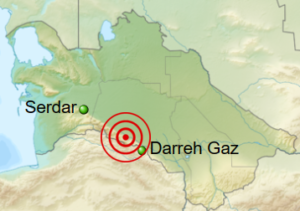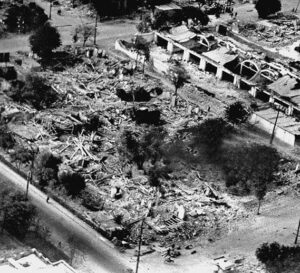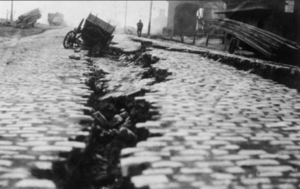 What could make a nation go through an earthquake and refuse help from another nation, like the United States? It seems like a strange question, but it is valid. On October 6, 1948, a magnitude 7.3 earthquake leveled Ashgabat, the capital of the Turkmen Soviet Socialist Republic—now Turkmenistan. The quake killed between 70,000 and 100,000 people. The true number will never be known. In fact, most information of the scope of the disaster remained unknown outside Central Asia until 1973, when archival records were finally unsealed by local officials. So…why seal the records…of an earthquake??
What could make a nation go through an earthquake and refuse help from another nation, like the United States? It seems like a strange question, but it is valid. On October 6, 1948, a magnitude 7.3 earthquake leveled Ashgabat, the capital of the Turkmen Soviet Socialist Republic—now Turkmenistan. The quake killed between 70,000 and 100,000 people. The true number will never be known. In fact, most information of the scope of the disaster remained unknown outside Central Asia until 1973, when archival records were finally unsealed by local officials. So…why seal the records…of an earthquake??
The town of Ashgabat lies at the foot of the Kopet-Dag Mountain range near the border with Iran. The area is geologically unstable and earthquake prone. That said, why should a large earthquake in an earthquake-prone area need to be hidden? Ashgabat was originally a czarist outpost, founded in 1881. The town grew quickly during World War II, due to evacuees from the war zone. The population grew to an estimated 150,000 people. With a huge influx of people came the need for a lot of new housing, so single-story houses of unreinforced brick and stone, with heavy roofs of packed clay were quickly built, without regard for the need for earthquake proofing. I suppose that was the reason that the authorities didn’t want anyone to come in to help or to know the details of the catastrophe or the number of victims. The schools, hospitals, and other public buildings were built in the same shoddy way. It was wartime, so it may have been that supplies were scarce, or that proper time was not spent on the construction. Of course, less was known about how earthquakes affect buildings too, and even though there were existing seismic standards, they were seldom met. The builders greatly underestimated the earthquake danger, and that was a fact. A 1929 quake had already caused significant property damage, but strangely, the fault zone had been unusually inactive. I suppose this could have been a warning sign. When it is overdue, it may be a sign of an impending catastrophe.
In this case, that was exactly what happened. On October 6, 1948, at 1:17am, with few people awake. Suddenly, they an ominous rumbling from the mountains, followed immediately by violent vertical shaking. It was actually two strong shocks seconds apart, and just as suddenly, Ashgabat was reduced to rubble. There was no escape…there was no time for escape. The buildings were standing one second and collapsed the next. The thing that is the most shocking was that many of the survivors, who had been conditioned by propaganda in the acute early phase of the Cold War, thought that the city had been hit by an American atomic bomb. And the government did nothing to correct their misguided thinking. So, the country did not seek help from the United States.
As suddenly as it had occurred, the quake severed all communications with the outside world. There were no emergency centers, because hospitals, clinics, and pharmacies lay in ruins. The few remaining uninjured rescue workers, members of the city’s emergency services struggled in the darkness to help the injured. Doctors, many of whom had served in the war, pulled equipment from the ruins to set up an emergency station in Karl Marx Square. Finally, by the afternoon, reinforcements and supplies began to arrive from Tashkent and Baku. Nevertheless, the number of casualties, and the inherent difficulty of evacuating gravely wounded people, meant that help came too late for many. It was estimated that half of an estimated thirty thousand people who  had life-threatening injuries died from lack of early treatment…many people died before they could even be pulled from the rubble.
had life-threatening injuries died from lack of early treatment…many people died before they could even be pulled from the rubble.
While the city workers immediately ran to the damaged central headquarters of the Communist Party, where they were told by the party’s first secretary, S Batirova to take an undamaged automobile and head northward to a functioning telephone line, and soldiers stationed at the airport used an aircraft radio to contact Baku and Sverdlovsk, it was still many hours before any details reached areas from which aid could be dispatched.Unfortunately, that wasn’t much help either, because the railway station was in ruins, tracks were blocked, the airport control tower was destroyed, and the airport and roads could not handle heavy traffic. It would take hours and even days, to get the much-needed rescue support the city needed.
Of course, because of the misguided concept that the Americans were somehow involved, the precise death toll will never be known for sure. Estimates range from a shockingly low number of 400, suggested by Nature magazine in 1948, to a more likely number of 110,000. The dead were buried in mass graves. They were not counted or identified, adding to the confusion. There were roughly 50,000 survivors in a city that had previously had a population of approximately 150,000. That suggests that a death toll of 80,000 to 100,000, or about two-thirds of the population is a more accurate number.
The death toll was enormous, and that could have also accounted for the lack of emergency workers. It’s highly likely that many of them were among the dead or injured…not to mention the fact that there may have been a gross shortage of qualified rescue workers in the poorest part of a country, which was just still recovering from long years of war, but the poor response from the rest of the Soviet Union became more and more unconscionable. On October 7, Pravda printed a brief article stating only that “geologists at the Russian Academy of Sciences had detected a strong earthquake.” The article also reported that there were supply shipments and of the evacuation of the wounded, but no mention of the scope of devastation or the number of casualties. Of course, the international press used Pravda’s limited and incorrect reportage about the quake as the source for their own news reports.
To make matters worse, a conspiracy of silence followed the destruction of Ashgabat. Most history books and almanacs of natural disasters actually omit the quake entirely!! In the typical Soviet propaganda style of the 1950’s, they actually praised the severely lacking reconstruction efforts that completely ignored seismological standards. One Soviet journalist who visited the city in 1953, later described being “forbidden to photograph the omnipresent ruins or to report a march of weeping survivors to the mass graves on the outskirts of the city.” Little was known about the devastating earthquake until 1973. Only on the twenty-fifth anniversary of the event, did officials in Turkmenistan begin to open sealed archives and acknowledge the terrible calamity. Why was this? It was largely because of the Cold War, when both sides were eager not to expose their strategic vulnerabilities. That still doesn’t make sense, however, because the destruction of Ashgabat neither compromised the Soviet Union’s defense system nor revealed grave internal weaknesses. The forced silence did nothing to improve domestic morale in Russia, and it created widespread resentment in Central Asia.  Internationally the Soviet Union could have gained propaganda points by publicizing the disaster and then criticizing the lack of response from the West, but for some reason, they didn’t so that either. Of course, the people in the Soviet Union lived in fear of Joseph Stalins sweeping purges and force silence and timidity. They didn’t dare speak of any kind of vulnerability. Until Stalin’s death in 1953, even referencing the event was considered a dangerous move. Financial aid was still desperately needed decades after the disaster, yet it still didn’t really come. Silence translated into slow reconstruction. Substantial portions of the city remain in ruins, and a significant portion of the population still lives in temporary, or inadequate and unsafe, dwellings to this day.
Internationally the Soviet Union could have gained propaganda points by publicizing the disaster and then criticizing the lack of response from the West, but for some reason, they didn’t so that either. Of course, the people in the Soviet Union lived in fear of Joseph Stalins sweeping purges and force silence and timidity. They didn’t dare speak of any kind of vulnerability. Until Stalin’s death in 1953, even referencing the event was considered a dangerous move. Financial aid was still desperately needed decades after the disaster, yet it still didn’t really come. Silence translated into slow reconstruction. Substantial portions of the city remain in ruins, and a significant portion of the population still lives in temporary, or inadequate and unsafe, dwellings to this day.


Leave a Reply